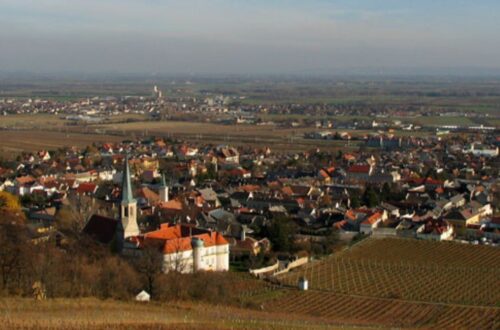
What is Smaragd wine?
In the Wachau region, there was no DAC for quite some time but top-growers created Vinea Wachau Nobilis Districtus (abbr Vinea Wachau). It started in 2018 with 24 members and has a three-tier system.
Quick reminder on what a DAC is. If you want to know more, feel free to check out my post on Austria’s DAC.
A DAC (Districtus Austriae Controllatus) is granted to a region when producers can agree on one or several grape varieties and a wine style, with associated regulations that best reflect their region. Once the DAC status is granted, only wines corresponding to that style are allowed to use the appellation name, while other wines must settle for the name of the region.
Smaragd wine is the highest tier in VWND’s three-tier system
The Wachau region in Austria was recently declared as a DAC (Districtus Austriae Controllatus), but prior to this, the top growers in the region established the Vinea Wachau Nobilis Districtus, which currently has around 200 members.
This system consists of three tiers.
The first tier is called Steinfeder and produces wines with an alcohol content ranging from 11% to 11.5%. These wines have a fresh character and are intended to be consumed young.
The second tier is Federspiel, which is comparable to a dry Kabinett and has a minimum must weight of 17% KMW and an alcohol content of 11.5% to 12.5%.
The highest tier is Smaragd, which is named after a lizard that inhabits the vineyards during hot spells and has a minimum alcohol content of 12% and can have up to 9 grams of residual sugar.
What are the characteristics of a Smaragd wine?
Well first, Smaragd wines, as you understood come from the Wachau, a subregion of Niederösterreich. There, the most significant grape variety is Grüner Veltliner, followed by Riesling in second place, and then Müller-Thurgau, Neuburger, Weissburgunder, Gelber Muskateller, Sauvignon Blanc, and even Zweigelt. So naturally, a Smaragd wine will be a white wine.
Thanks to the climate, they usually present fine acidity and structure.
Indeed, the Wachau wine region features weathered granite and gneiss that are often cracked, allowing vine roots to delve deep into the soil. The area also includes numerous terraces that rely on manual labor and dry stone walls to maintain them.
Water scarcity is a pressing issue in the region, which receives limited rainfall and has highly permeable soils. The Danube River has a significant influence on the area’s micro climates, as the warm air from the east meets the cold air from the north, resulting in significant fluctuations between daytime and nighttime temperatures.
Vinea Wachau sets strict rules for its members, prohibiting chaptalization, the use of concentrated must or mechanical concentrators, wood chips, and tannin additions, as well as alcohol-reducing techniques like reverse osmosis and spinning cones.
Most producers discourage malolactic fermentation, although partial malolactic fermentation can occur.
What are the best Smaragd wines?
Well, I hate making lists about the best Smaragd wines you can find, because it depends also a lot on your taste.
So, I’ll give two of my favourites (and feel free to comment with your favourites too!) Sign up for the newsletter for more, there I’m more able to go in detail when needed.
Weingut Alzinger likes to give Grüner Veltliner and especially Riesling skin contact. His Smaragd wines are aged in casks, while other are aged in stainless steel to maintain freshness. There is no malolactic fermentation. These wines are splendid wwith fine acidic structure, a lean but fruity character and raciness not sharp. The Grüner Veltliner Smaragd come from Loibenberg, Mühlpoint and Steinertal.
Weingut Knoll has vines mostly in the eastern part of the valley (Loiben and across the border of Kremstal). His most celebrated vineyard is Schütt : low-lying alluvial fan. The soil contains a great deal of primary rock and rubble. Knoll Senior doesn’t like a cool fermentation, thus his wines lack aroma and immediacy in youth. He prefers to capture typicity of each terroir and that they have sufficient structure. His Smaragd wines are powerful and high in alcohol. This high ripeness enabled him to produce BA and TBA in vintages such as 1998, 2000, 2006, 2007 & 2015.
Conclusion : What is Smaragd wine?
Smaragd wine is the highest tier in the Vinea Wachau Nobilis Districtus (VWND) three-tier system. It originates from the Wachau region in Austria, which was recently declared as a DAC (Districtus Austriae Controllatus). The VWND has around 200 members and consists of three tiers.
The highest tier, Smaragd, derives its name from a lizard that inhabits the vineyards during hot spells. Smaragd wines have a minimum alcohol content of 12% and can have up to 9 grams of residual sugar.
Smaragd wines from the Wachau region are predominantly white wines, with Grüner Veltliner being the most significant grape variety, followed by Riesling. The region’s climate contributes to the wines’ fine acidity and structure.
Some notable producers of Smaragd wines include Weingut Alzinger, known for skin contact and cask aging of their wines, and Weingut Knoll, whose Smaragd wines are powerful and high in alcohol. These producers focus on capturing the typicity of each terroir and ensuring sufficient structure in their wines.







